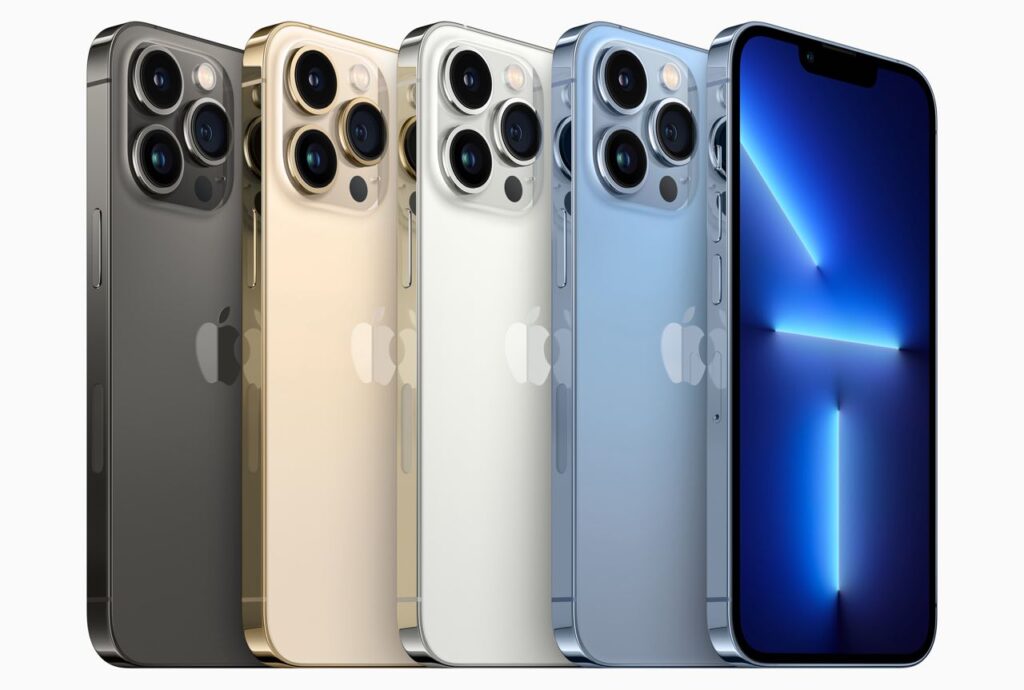- Apple's new iPad supports most of its modern features and services.
- The iPhone 13 makes a big play to become a cinematographer's tool.
Above: iPhone 13 Pro camera array. Photo courtesy Apple.
BitDepth#1321 for September 20, 2021
Tim Cook weathered the unenviable challenge of following Steve Jobs as the host of Apple’s product announcements by anchoring launch events that were once almost seances with a calm, almost relaxed sense of excitement about the new stuff he’d authorised for production.
To his credit, he’s downplayed Job’s signature “One more thing…” deploying it only for truly revolutionary and game-changing new products, which is to say that he hasn’t said it much at all since the Apple co-founder passed away.
That popular phrase, which always got a rise out of audiences, didn’t cross Cook’s lips during Apple’s launch of new products last Tuesday.
The company has managed, to a surprising degree, to make commodities out of its most popular products among its most faithful followers.
For the Apple diehard, it’s never about what tablet or phone brand to buy, it’s a matter of choosing the right iPad or iPhone.
That doesn’t grow the market though, and only cost-effective choices and truly exciting new features actually draw more than fans to buy.
Both options were on offer at last week’s launch, which offered a well-equipped iPad at US$329 sporting the A13, one of the company’s recent self-designed chips.
The baseline product supports the compelling features offered in other top-end iPads, including compatibility with the Apple Pen, a stylus that the company offers for its more recent tablets.
It’s half the price of this year’s iPad Pro, and most users won’t want for much by choosing it.
Getting a bigger hardware boost is the iPad Mini, an eight-inch version of the tablet that’s been given the new A15 processor and a much better screen.
Apple seemed to be positioning this device for people who want a work-capable tablet computer that fits into big engineering or medical pockets.
At US$499, it’s a harder sell without a specific use case that calls for a smaller size and faster processor than the new base model iPad.
The Apple Watch thins out its face bezel a bit to earn some more usable space on the tiny screen and adds improved dust and shock resistance.
All watch owners will likely benefit from improved integration with Apple’s Fitness + service, which brings a welcome social element to exercising in a pandemic.
I’m not a watch person at all, so it’s hard to get worked up about incremental improvements, but there was little to report here to entice an existing Apple Watch owner.

That wasn’t the case with the new iPhone 13, and more specifically, the iPhone 13 Pro Max, the top of the line smartphone in Apple’s new lineup.
If you want a device to take calls, do social media and messaging and take the occasional snap, the base model iPhone 13, equipped with the new A15 processor will do just fine.
But if you think of a smartphone as a visual arts tool though, prepare yourself for serious thirst when you get to the specifications of the iPhone 13 Pro Max.
Apple boasts of better low-light performance for the new phone, and putting a bigger sensor and faster glass in their top-of-the line smartphone will definitely do that.
The new Pro Max adds a wider ultra-wide lens and longer telephoto lens to its array, with the 77 mm telephoto with an f 2.8 aperture, offering an ideal portrait lens length.
Apple claims a 3x optical zoom with this lens, but manufacturers play fast and loose with the meaning of that term, so it remains to be seen how that is implemented in the device.
The standard wide 26 mm lens sports an f 1.5 aperture and the ultra-wide 13 mm lens is set at f 1.8.
These are potent specifications for any photographer’s camera bag, having them attached to a smartphone is beyond useful.
I haven’t felt this excited about a smartphone’s capture capabilities since seeing the specifications of Huawei’s P30 Pro.
Apple manages to top that hardware achievement with a new software feature, rack focus.
Until now, rack focusing, the smooth move of a focus point from foreground to background is something you might have seen — but hardly noticed — in a film or television show.
To do it, you needed a lens with a special grip or gearing attachment, measuring tape and a crew specialist called a focus puller.
He’s out of work now, and the measuring tape goes back into the tool box, because Apple has automated rack focus as part of its new Cinematic mode.
When someone enters the smartphone’s frame, the lens smoothly switches focus from the background to them. Any iPhone 13 cinematographer can tap two spots within the frame and let the software do the work.
As if that weren’t enough of a lure for the nascent filmmaker, the processor on the new iPhone is beefy enough to allow editing of footage shot in either Apple’s native ProRes format or DolbyVision directly on the device.
So in addition to ditching the focus puller, you can also get rid of an editor and editing suite.
To capture in ProRes, you will need a Pro Max with more than the baseline 128GB of storage.
“It will change the language of cinema in a very positive way,” cinematographer Greig Fraser said of the new iPhone in a promotional video.
That may be Apple-inspired hype, but there’s no question that these new artificial intelligence powered tools will make that language easier for almost anyone to speak.



